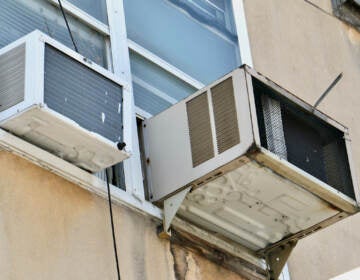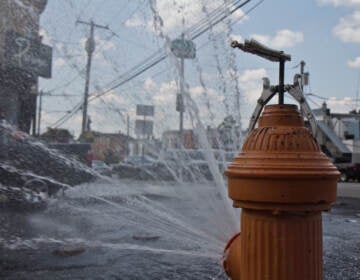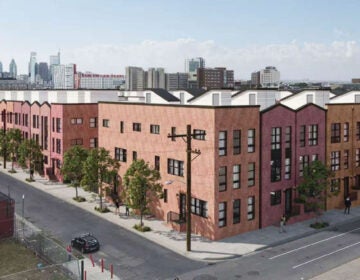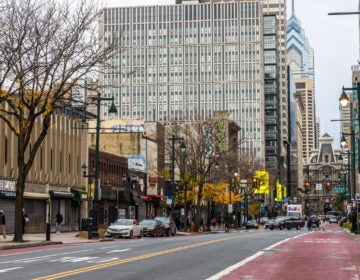In Philly, demand is ‘overwhelming’ for Pa.’s LIHEAP air conditioner program
With more than a month left of the program, over a dozen county agencies have waitlists. “Demand is outrageous,” one official said.
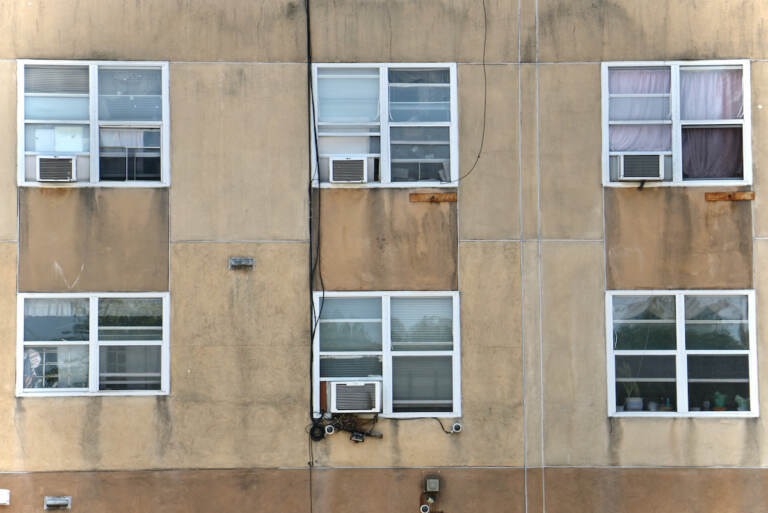
Window air conditioners in a building on Race Street. (Emma Lee/WHYY)
Have a question about Philly’s neighborhoods or the systems that shape them? PlanPhilly reporters want to hear from you! Ask us a question or send us a story idea you think we should cover.
Kimyatta Connor does not have any air conditioning in her two-story home in Philadelphia’s Hunting Park neighborhood. She used a box fan to try to stay cool when temperatures soared into the upper nineties earlier this month — but said the fan only blew hot air.
“It was a heat wave, and I had a darn fan,” she said. “I was in here sweating bullets. People die from heat stroke.”
It’s the second summer that Connor has tried to sign up for a state pilot program that provides free air conditioners through a federally funded energy assistance program traditionally used in Pennsylvania to help low-income households pay their heating bills. Both years, she has not been able to successfully sign up.
This summer, Connor said she brought documentation proving her eligibility for the program to a Neighborhood Energy Center managed by the Energy Coordinating Agency, one of two agencies that administer the program in Philadelphia. She said she followed up by phone, but never heard back.
“I don’t know what’s the hold-up,” Connor said. “I don’t know what’s going on.”
The Energy Coordinating Agency, the state’s top provider of air conditioning units and repairs through the program last summer, has been swamped with inquiries and has already obligated its entire allocation for the season, officials said. PHDC, the other agency that administers the program in the city, has also run out of funding.
With more than a month left of summer, this year’s $5.3 million budget for the cooling program — significantly less than the over $8 million local agencies were allocated last summer — has not been enough to meet demand in some parts of the state. Already, more than a dozen county-level agencies have told state officials they have depleted their funds and are starting waitlists.
“The demand is overwhelming,” said Cynthia Olidge, director of heating at the Energy Coordinating Agency. “Because of the temperature … demand is outrageous.”
Pennsylvania’s LIHEAP cooling pilot program is now in its third year, and provides eligible households either two Energy Star–rated room air conditioner units, one unit and a fan, or repair or replacement of an existing but broken central air conditioning system or heat pump.
It’s funded with federal Low Income Home Energy Assistance Program money left over from the winter heating season.
Eligibility for the program is narrow. In order to qualify, a household must have received LIHEAP assistance this past November through April or be currently receiving federally funded weatherization assistance.
Because of this, there is no centralized way to apply for the program directly. Some county-level weatherization agencies reached out to eligible clients to enroll them in the program. State officials recommend that people who qualify for the LIHEAP cooling program call their local weatherization agency if they have not yet heard from them.
In Philly, the Energy Coordinating Agency contacted roughly 300 people who were already in the organization’s system because they had received qualifying assistance this past winter, officials said.
The agency also received hundreds of emails, phone calls and walk-in visits about the program, as well as referrals from Neighborhood Energy Centers, elected officials and doctors, Olidge said.
“They haven’t stopped coming in,” she said.
But the Energy Coordinating Agency cannot accommodate all of these inquiries. As of Tuesday, the agency had served roughly 575 households through the cooling program this summer and had jobs pending for roughly 50 more. The agency has not had enough funding or staff capacity to address at least 1,000 other inquiries about the program so far this summer, and estimates that number could grow to 2,000 before the season is over.
PHDC expects to serve roughly 130 households through the program this summer, but lacks funding to serve roughly 70 other households who tried to sign up, said spokesperson Jamila Davis.
It’s not just Philly where demand for air conditioners has outpaced funding for the LIHEAP cooling program.
Action Housing, which serves Allegheny, Washington and Greene counties and was the second biggest provider through the program last summer, had a waitlist of around 500 households as of Tuesday, said Director of Weatherization Services Pamela Miljus. The agency has only served 60 households so far this summer and plans to perform jobs for at least 40 more off the waitlist.
“The demand is far greater than the funding that we will have to spend,” Miljus said in an email.
Luxton thinks above-normal temperatures so far this summer have driven demand for air conditioners, just as he sees winter applications for LIHEAP assistance surge during cold weather.
“This summer thus far has been relentless, and that directly impacts this overwhelming number of folks applying for the program,” he said.
Advocates say rising temperatures in Pennsylvania due in part to human-caused climate change make air conditioning increasingly crucial. But in Philadelphia, resources are limited.
A 2023 report by the nonprofit Esperanza and Community Legal Services called on lawmakers to allocate permanent state funding to supplement Pennsylvania’s federal LIHEAP allocation to provide not only air conditioners but also cooling bill assistance. A survey by the two organizations found that while a small fraction of respondents in low-income Philly neighborhoods lacked air conditioners in their homes, a majority struggled to afford their summer energy bills.
In Philadelphia, where elements of the built environment like pavement and buildings trap heat and can raise temperatures further, the number of cooling degree days — a measure used to estimate energy requirements for air conditioning that calculates how much warmer the mean temperature at a location is than 65°F — has trended up in the summer in recent decades.
Luxton said his agency could use double the funding for the LIHEAP cooling program next summer.
“Even then, we might be sitting here at the same time [saying] that wasn’t enough either,” he said. “It clearly is getting hotter, and that just simply drives the folks that are wanting an air conditioner. It makes perfect sense. In the poorest big city in the country, we have to realize that and build for it.”
Some Pennsylvanians have also struggled with an opaque process for signing up for the program.
Tina Bryant, a resident of North Philly with respiratory health issues, said she hoped to receive a new air conditioner through the program, since her current window unit does not effectively cool her home. But she was not aware that in order to qualify, she would need to have received LIHEAP assistance this past winter. She has received winter LIHEAP assistance in the past, but recently stopped applying for it, since her heating bill is now included in her rent, which complicates the application process, she said.
Without understanding the eligibility requirements or enrollment process, Bryant said she tried unsuccessfully to sign up for the air conditioner program through Pennsylvania’s benefits portal over the course of two weeks — an exhausting task since she is recovering from a stroke.
“They’re making it harder … for people with disabilities and older people,” she said. “We need help, and we can’t get it.”
The program closes Aug. 31.

Subscribe to PlanPhilly
WHYY is your source for fact-based, in-depth journalism and information. As a nonprofit organization, we rely on financial support from readers like you. Please give today.




